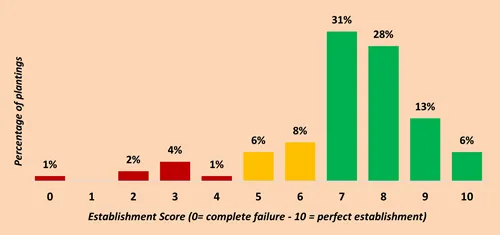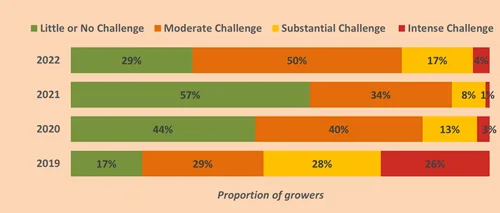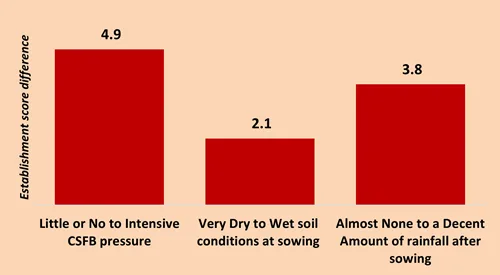Published on 1st December 2022
Seed & Establishment
Substantially Increased OSR Crop Confirmed in Annual Grower Poll

OSR Establishment Results
Despite a much more challenging autumn and later sowing that many planned, winter oilseed rape establishment across the country is remarkably good, reveal initial results from the fourth year of the Dekalb national establishment poll. This and the marked increase in plantings confirmed by the late October survey suggests the area of crop coming into next spring could be a good 10% up on 2022.
Reports from over 230 growers responsible for 25,000 ha of current season plantings well-spread across the main arable areas of Great Britain, indicate only just over 6% of this year’s crop is likely to be the subject of breeders’ establishment scheme claims for failure.
At the same time, they rate over three quarters of this season’s crop at 7 or more for establishment on the poll’s standard 0-10 scale, with just 8% rated as less than 5 (Figure 1).
Figure 1: OSR Establishment Score

Source: Dekalb National OSR Establishment Poll 2022, Bayer
“Barring any major winter or early spring issues, these findings point to an overall crop survival to flowering similar to the past two years at around 90% of plantings,” says Bayer seed campaign manager and poll co-ordinator, Lizzie Carr-Archer.
“This is a vast improvement on the 67% survival to spring we recorded in the last particularly challenging establishment season of 2019/20. And it’s certainly not what large numbers of growers were expecting as recently as September after such a bone-dry summer.”
With almost two thirds of growers reporting very or fairly dry conditions at sowing and only just over a third considering them at least reasonable, this year’s poll shows moisture levels at sowing were actually worse than 2019 (Figure 2).
Figure 2: Moisture Conditions at Sowing (2022 vs 2019)

Source: Dekalb National OSR Studies 2019 & 2022, Bayer
Together with sowing delays prompted by the very dry conditions, this left many crops particularly open to the normal late August/early September cabbage stem flea beetle challenge.
While noticeably higher than the past two years, however, overall CSFB pressure proved to be well below the level of 2019, with only just over 20% of growers reporting substantial and intense challenges from the pest compared to more than 50% three seasons ago (Figure 3).
Figure 3: CSFB Pressure at Establishment (2019 - 2022)

Source: Dekalb National OSR Studies 2019 to 2022, Bayer
This and the fact that over 80% of growers reported receiving enough rainfall between sowing and late-October, almost certainly accounts for the very much better position of the current crop going into winter.
“As ever, our study shows considerable differences between the regions in CSFB pressures and moisture conditions both at and after sowing,” Ms Carr-Archer notes. “Even those areas faring worst in terms of pest pressure and dryness, though, have markedly better average establishment scores than 2019.
“Not surprisingly perhaps, the very much drier August led to a clear reversal of the trend to earlier drilling we’ve been recording over the past three seasons, with nearly 60% of crops being sown after August 20th against 45% in 2021.
“Unlike recent years too, it also meant that earlier sown crops didn’t necessarily establish better than those going in at a more traditional late-August timing, despite what continue to be higher CSFB pressures at this time. This reinforces the fundamental importance of the balance between pest pressure and moisture conditions in determining OSR establishment.
“Our latest data show CSFB pressure continues to have a greater impact on establishment than soil moisture,” she points out. “Crucially too, they really underline that the real clincher in moisture terms is the amount of rainfall received after sowing rather than conditions at drilling. Indeed, the difference in average establishment score between the extremes here was almost twice that between the extremes of moisture at sowing (Figure 4).”
Figure 4: Establishment Score Differences between Extremes of Conditions

Source: Dekalb National OSR Establishment Poll 2022, Bayer
With drilling conditions so dry, it is not surprising that this year’s poll shows few, if any, overall differences in establishment success either between different establishment regimes or variety types.
A noticeable gap was, however, evident between hybrids and pure line varieties where crops were under the particular challenge of less than adequate rainfall after sowing
(Figure 5). Together with lower levels of re-drilling (8% vs 11%) here, this underlines the risk management benefits of modern hybrids’ establishment and early development vigour.
Figure 5: Establishment Score by Variety Type & Conditions

*Excluding Clearfield, clubroot resistant and HOLL hybrids for fair comparison
Source: Dekalb National OSR Establishment Poll 2022, Bayer
“The greater CSFB pressures this season inevitably led to greater insecticide use at establishment than in recent years,” Ms Carr-Archer reports.
“Even so, it’s really encouraging to see the proportion of growers deliberately avoiding insecticide spraying increasingly slightly from 33% last season to 37%. Especially so, since two thirds of those overall – and more than three quarters of mainstream hybrid growers – doing so still recorded establishment scores of 7 or more.
“This season’s poll gives particular confidence to those not letting the very dry early autumn put them off sticking with or increasing their winter OSR growing for 2023,” she concludes.
“There’s a lot of water to go under the bridge yet, of course. Having said that, the critical importance of establishment quality to crop performance and the extent to which both good crop establishment and later sowing are known to reduce the impact of CSFB larvae leaves us quietly confident of a substantial year-on-year increase in the crop going to harvest.
“After all, even in the particularly damaging CSFB season of 2019/20 growers only recorded an average crop loss of around 6% between early spring and harvest.”



